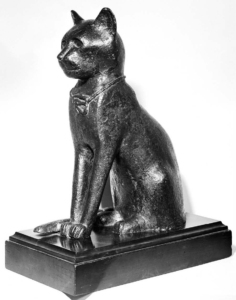
30
MarDetroit: Conservation of Ancient Egyptian Metals: Latest Perspectives
Registration is Required
Presented by: Dr. Almoatzbellah Elshahawi; Conservator at the Egyptian Museum in Cairo
- 2:30 PM CTDetroit
- Zoom
- + Add to Calendar
Abstracts Information
An Authenticity Study of an Egyptian Bronze Cat: Modern or Ancient?
 In ancient times cats were worshipped as gods. Ancient Egyptians revered cats, and worshiped the goddess Bastet. Egypt was emerging as a hub for the emerging field of archaeology more than two millennia later. Excavations at Bubastis, also known as Tell Basta, were directed by Édouard Naville, a Swiss archaeologist and expert on Egyptology, from 1887 to 1889. Many different cat depictions, ranging in size from life-sized to tiny votive bronzes, were discovered during his excavations, which came after years of uncontrolled digging. The European art market and museums were overrun with thousands of cat statuettes at the turn of the century. Reportedly, there was a market for fakes as a result of the attractive cat bronzes’ popularity. For many years, a bronze cat statuette at the Getty Villa was believed to be one of these imitations and was left alone in storage. But recent discoveries and scientific tests suggest that it is, in fact, ancient .
In ancient times cats were worshipped as gods. Ancient Egyptians revered cats, and worshiped the goddess Bastet. Egypt was emerging as a hub for the emerging field of archaeology more than two millennia later. Excavations at Bubastis, also known as Tell Basta, were directed by Édouard Naville, a Swiss archaeologist and expert on Egyptology, from 1887 to 1889. Many different cat depictions, ranging in size from life-sized to tiny votive bronzes, were discovered during his excavations, which came after years of uncontrolled digging. The European art market and museums were overrun with thousands of cat statuettes at the turn of the century. Reportedly, there was a market for fakes as a result of the attractive cat bronzes’ popularity. For many years, a bronze cat statuette at the Getty Villa was believed to be one of these imitations and was left alone in storage. But recent discoveries and scientific tests suggest that it is, in fact, ancient .
Conservation and Treatment of Ancient Coinage
Ancient coins are one of the most important sources of information for numismatists/historians when it comes to interpreting the past. We can learn a lot about the culture of the time period because most coins can be easily dated. This is partly because, unlike most other ancient artifacts, they are typically stamped with text and images of rulers from a specific period. Furthermore, the materials used to make coins, such as bronze, silver, and gold, have assisted historians date the coins and reveal the culture’s affluence. Because of their historical context significance and the valuable information they contain, ancient coins must be preserved against damage and corrosion. My presentation will be focused on the conservation and treatment of ancient bronze coins, concluding with storage recommendations.
Speaker Bio
 Almoatzbellah Elshahawi is a conservator at the Egyptian Museum in Cairo since 2021, specializing in ancient Egyptian works on metals and coins. He is a graduated intern at the J. Paul Getty Museum for one year (2019-2020). He received a Master’s degree in Conservation, Cairo University, 2017. Elshahawi was a 2009-2013 Cairo University Fellow. He was a conservator at the Grand Egyptian Museum-Conservation Center (GEM-CC) for six years, and most recently received a PhD in metal conservation from Cairo University.
Almoatzbellah Elshahawi is a conservator at the Egyptian Museum in Cairo since 2021, specializing in ancient Egyptian works on metals and coins. He is a graduated intern at the J. Paul Getty Museum for one year (2019-2020). He received a Master’s degree in Conservation, Cairo University, 2017. Elshahawi was a 2009-2013 Cairo University Fellow. He was a conservator at the Grand Egyptian Museum-Conservation Center (GEM-CC) for six years, and most recently received a PhD in metal conservation from Cairo University.

